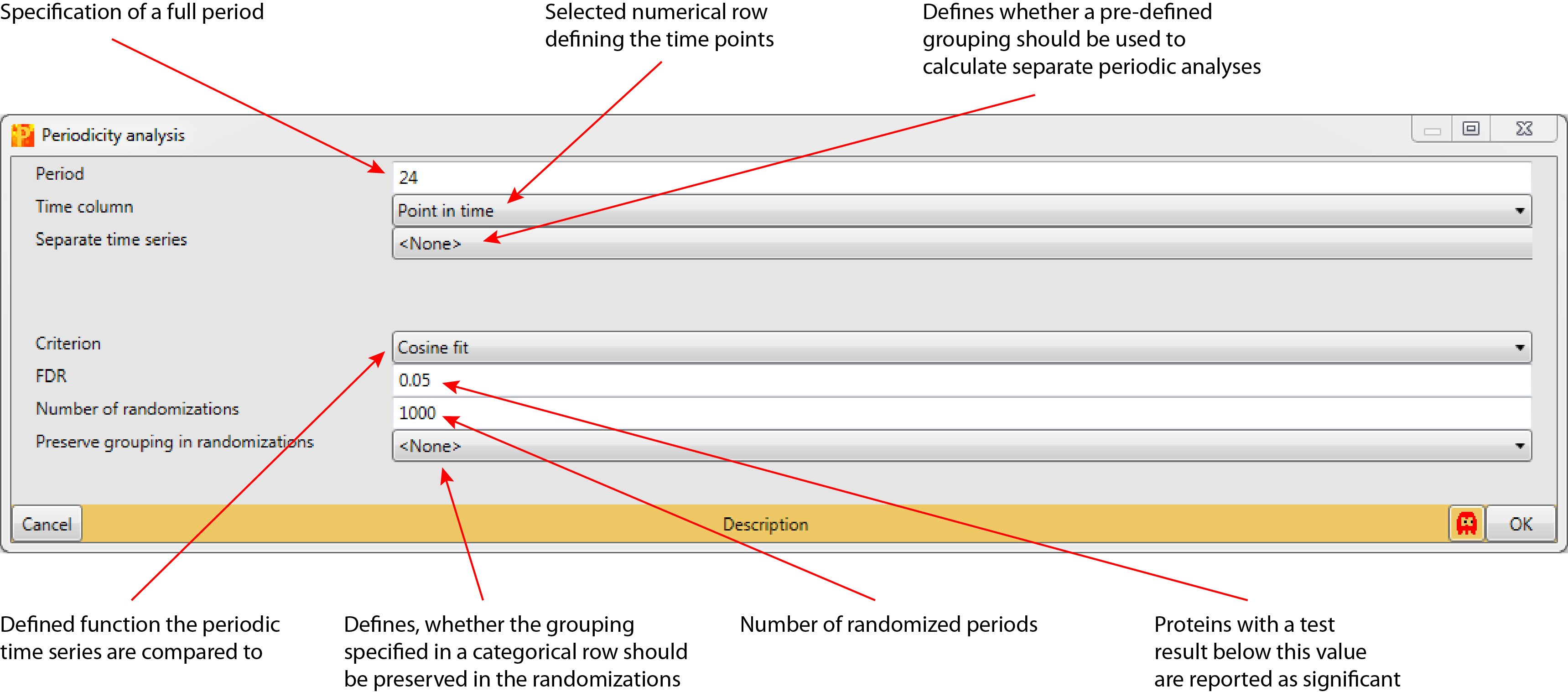Periodicity analysis
1 General
- Type: - Matrix Processing
- Heading: - Time series
- Source code: not public.
2 Brief description
Test if profiles are periodic. The period length is set to a fixed value by the user.
3 Parameters
3.1 Period
Defines when a full period is passed (default: 24 according to hours of the day).
3.2 Time column
Selected numerical row, which defines the time points (default: first numerical row). Proteins are listed in rows, whereas columns represent a specific point in time.
3.3 Separate time series
Defines whether separate time series analyses should be applied according to a pre-defined grouping, which is specified in a categorical row (default: <None>). It can be selected from a list including all available groupings of the matrix.
3.4 Sort by
This parameter is just relevant, if the parameter “Separate time series” is set to a grouping. It specifies, which group will be used for sorting.
3.5 Criterion
Defines the function to what the periodic time series are compared to (default: Cosine fit). The function can be selected from a pre-defined list.
3.6 FDR
Rows (proteins) with a test result below this value are reported as significant (default: 0.05).
3.7 Number of randomizations
Specifies the number of randomized periods (default: 1000).
3.8 Preserve grouping in randomizations
Defines, whether the grouping specified in a categorical row should be preserved in the randomizations (default: <None>). It can be selected from a list including all available groupings of the matrix.
4 Parameter window

5 Examples
5.1 In-Vivo Quantitative Proteomics Reveals a Key Contribution of Post-Transcriptional Mechanisms to the Circadian Regulation of Liver Metabolism
The algorithms were first applied in 2014 by Robles et. al.1.
Abstract
Circadian clocks are endogenous oscillators that drive the rhythmic expression of a broad array of genes, orchestrating metabolism and physiology. Recent evidence indicates that post-transcriptional and post-translational mechanisms play essential roles in modulating temporal gene expression for proper circadian function, particularly for the molecular mechanism of the clock. Due to technical limitations in large-scale, quantitative protein measurements, it remains unresolved to what extent the circadian clock regulates metabolism by driving rhythms of protein abundance. Therefore, we aimed to identify global circadian oscillations of the proteome in the mouse liver by applying in vivo SILAC mouse technology in combination with state of the art mass spectrometry. Among the 3000 proteins accurately quantified across two consecutive cycles, 6% showed circadian oscillations with a defined phase of expression. Interestingly, daily rhythms of one fifth of the liver proteins were not accompanied by changes at the transcript level. The oscillations of almost half of the cycling proteome were delayed by more than six hours with respect to the corresponding, rhythmic mRNA. Strikingly we observed that the length of the time lag between mRNA and protein cycles varies across the day. Our analysis revealed a high temporal coordination in the abundance of proteins involved in the same metabolic process, such as xenobiotic detoxification. Apart from liver specific metabolic pathways, we identified many other essential cellular processes in which protein levels are under circadian control, for instance vesicle trafficking and protein folding. Our large-scale proteomic analysis reveals thus that circadian post-transcriptional and post-translational mechanisms play a key role in the temporal orchestration of liver metabolism and physiology.